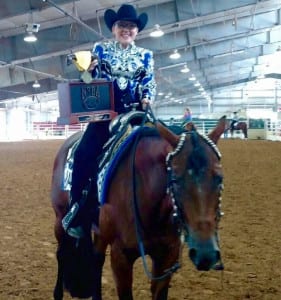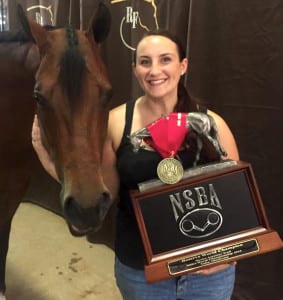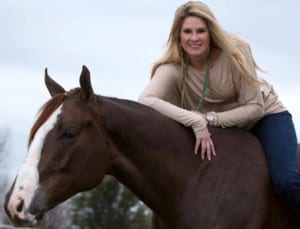Have you ever been in the middle of the arena all by yourself, ready to perform your pattern, and you blanked out completely? Most of us have been there, and the experience surely ranks up there as one of our least favorite parts of showing.
Memorizing patterns is one task that can be a great source of delight or dismay. If you nail your pattern, your day is complete, but the memory of a pattern can disappear into thin air at the most inopportune time, spoiling your go.
There is hope, however, especially if this pattern idea is all new to you, or if you’re approaching a high-stakes show like the upcoming AQHA Level 1 Championships. GoHorseShow sought out some tried and true tips for memorizing patterns from trainers, amateurs, youth, and even educators and scientists who understand brain power best.
What Experts Say to Do
Experts, including educators and scientists who study the brain, say to do exactly what some savvy competitors have already learned. Appealing to your types of intelligence, your emotions, or various parts of your brain is the key.
Here are some well-known memorization strategies:
• Read it
• Draw or write the pattern
• Say the steps out loud
• Cover it up and say it
• Break the pattern into sections or “chunk it”
• Physically practice it
• Watch someone practice or perform it
• Teach it to someone else
A 2013 article from learningworksforkids.com advised learners to “treat your brain like a garden,” and to stay hydrated and provide nutrition for the brain with “memory-boosting vitamins such as Vitamin B12, Folic Acid, and food such as salmon and fruits.” They also recommended giving that brain some rest to keep it at optimum performance.
What the Trainers Do
 Kip Larson (pictured middle) of Larson Performance Horses in Arlington, Washington, has been coaching riders, including two-time AQHA Select World All-Around Champion Linda Coakley, since 1991 to the tune of multiple world titles. His recipe for success includes taking accountability and learning by doing.
Kip Larson (pictured middle) of Larson Performance Horses in Arlington, Washington, has been coaching riders, including two-time AQHA Select World All-Around Champion Linda Coakley, since 1991 to the tune of multiple world titles. His recipe for success includes taking accountability and learning by doing.
“First and foremost, we instill to our customers it is their job to memorize their patterns. We ask them to at least know their patterns before they come to the pen for schooling, so we don’t waste valuable time sitting in the middle of the arena learning the pattern,” he explains.
“We always start with walking the pattern and learning all our transition spots and lines of travel. Once we have that down, we start at the beginning and break the pattern down into elements. We go through those elements from the beginning to the end, working on our line of travel and transitions, never moving to the next element until we conquer the previous one. Once we have all the elements down, we put them all together and run it as a pattern and fine tune any parts needing adjustment. These strategies really help our customers to become pattern-perfect,” says Larson.
What the Riders Do
 Since most Amateurs and Youth have been through years of school, they have their study skills down pat. Youth Natasha Blanchard of Lumberton, Texas, uses several methods to memorize: “For Trail, I read the steps they want us to take and look at the pattern. I practice it with my horse, and I walk it with my trainer. I try watch at least one horse execute the pattern before I show,” she says.
Since most Amateurs and Youth have been through years of school, they have their study skills down pat. Youth Natasha Blanchard of Lumberton, Texas, uses several methods to memorize: “For Trail, I read the steps they want us to take and look at the pattern. I practice it with my horse, and I walk it with my trainer. I try watch at least one horse execute the pattern before I show,” she says.
Even though the specialty class for youth Steve Wheat of Benton, Louisiana is Western Pleasure, he says he’s no stranger to studying. He advises other youth, “Get your parents or someone to quiz you, and jot things down if you need to so you know how to do the pattern.”
 Novice Amateur Morgan Brehm reviews the pattern and memorizes it on paper, and then visualizes herself riding through the pattern. “I do this in a quiet area where I can focus on the different aspects of the pattern. I repeat it in my head until the pattern is perfect. When that fails I use the force,” she quips.
Novice Amateur Morgan Brehm reviews the pattern and memorizes it on paper, and then visualizes herself riding through the pattern. “I do this in a quiet area where I can focus on the different aspects of the pattern. I repeat it in my head until the pattern is perfect. When that fails I use the force,” she quips.
Amateur Jennifer Schexnayder admits patterns have been extremely difficult all her life since she’s dyslexic and has auditory problems. Because of that, she has implemented several smart practices.
“Fortunately I have an amazing mom that still comes to shows with me, and she and I will still go over our patterns to this day. Unfortunately, she shows in Select so every once in a while we will get them mixed up. The first thing I do is walk down to the arena to see exactly how the show pen is positioned. Next, I try to figure out what gate we are entering and where the start cone might be. As soon as I have visualized all the cones, I start to ride the pattern as if I’m in the arena showing.”
 Schexnayder continues, “If the pattern calls for a circle or straight line I always try to find some type of a marker on the walls, beams, gates, etc. to keep my pattern symmetrical, especially when there is only one cone in the pen. When visualizing the pattern I will move my leg for every lead and turn even though I’m just standing or sitting on my horse. For instance, if I’m in the class and need to pick up the right lead and I didn’t tell myself to use my left leg, there’s a good chance I might use my right leg and catch the left lead and oops, I’m out. For me going over every small detail is extremely important.”
Schexnayder continues, “If the pattern calls for a circle or straight line I always try to find some type of a marker on the walls, beams, gates, etc. to keep my pattern symmetrical, especially when there is only one cone in the pen. When visualizing the pattern I will move my leg for every lead and turn even though I’m just standing or sitting on my horse. For instance, if I’m in the class and need to pick up the right lead and I didn’t tell myself to use my left leg, there’s a good chance I might use my right leg and catch the left lead and oops, I’m out. For me going over every small detail is extremely important.”
Jennifer also practices with her horse once she feels confident. “After I have visualized what I would like to do, then I will practice parts of the pattern on my horse, normally in a straight line. Once I feel confident about the pattern knowing all the parts, then the cones come out along with Chad, my trainer. For me it’s all about repetition. I have even been known to tell complete strangers at the back gate my pattern if I can’t find any barn friends or my mom. It helps to say it out loud a few times before going into the pen. Most importantly, sit up straight and smile even if things do not go accordingly.”
Avoiding the Choke
Despite how well we know something, choking on a test is a real-world problem for many, and patterns really are a kind of test. When we’re nervous about a class, that same syndrome can happen. One solution to try: write about it beforehand.
Some psychologists at University of Chicago found out that writing about your thoughts and feelings before you perform, especially if you’re a worrier or anxious about it, helps you remember what you studied better.
“College students who first wrote about their thoughts and feelings about an upcoming math exam for 10 minutes solved more arithmetic problems than did students who sat quietly. And the writing task improved the scores of highly anxious ninth graders so much that they performed as well as students with low anxiety on a biology final exam. (Science, January 2013).”
So it turns out there are lots of ways to survive pattern pitfalls, and it’s all about finding what works best for you. What methods have you found that work well for memorizing patterns? We want to know. Please leave your comments below or on our Facebook page.








